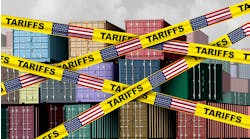COVID-19 Makes the Case for Resilient Manufacturing
The COVID-19 pandemic is causing not just manufacturers, but entire nations, to reevaluate global supply chains.
French President Emmanuel Macron—a champion of globalization—says supply chains will “need to become more French.” Germany’s health minister Jens Spahn wants to minimize “one-sided dependencies in order to win back national sovereignty.”
Japan has moved first; its national bank is allocating billions of dollars to assist its domestic manufacturers in reshoring production from China. Subsidies will cover relocation expenses and investments in labor-saving automation (including robots). Australia and South Korea are also contemplating reshoring.
Similar ideas are percolating in the United States. “We would like to bring supply chains home,” says White House economic adviser Larry Kudlow. America needs to “bring home its manufacturing capabilities and supply chains for essential medicines,” says Peter Navarro, President Trump’s top manufacturing adviser. In Congress, Senator Tom Cotton (R-Arkansas) has introduced legislation to re-shore pharmaceutical supply chains; 80% of active drug ingredients are produced in India and China.
Should nations reshore everything? No—there are reasons for international trade, which has raised living standards and lifted more than a billion people out of poverty since 1990, according to the World Bank.
Well then, how about reshoring some things—those critical to national security? Probably a good idea—if we can correctly foresee which goods and supply chains will be critical in the future. A further complication: the next supply shock could occur anywhere and may or may not be a pandemic.
A safer bet is to invest in resilience—a manufacturing sector that can adjust in real time to emerging global threats by shifting the location of production while minimizing any loss in capacity or product quality. Importantly, we know how to increase resilience.
First and foremost, management matters. A recent article in Harvard Business Review lays out a three-step plan for manufacturing executives: map out your suppliers (including those far up the supply chain), conduct a vulnerability analysis, and develop contingency plans considering both the costs and benefits.
Technology also matters. Think smart manufacturing, or Industry 4.0—the digitalization of the production process across the value chain, coupled with data analytics to allow for real-time decisions. Practitioners have a first-mover advantage, which equates to resilience from a supply or demand shock.
Smart manufacturing relies on a suite of technologies (5G, blockchain, sensor technology, augmented reality, digital twins, etc.), and firms employing these technologies are stepping up during the current crisis. For example, artificial intelligence (AI) and machine learning, including deep learning, is being used to efficiently identify potential drug treatments and vaccines. The UK company Benevolent AI used machine learning to identify existing drugs (such as Eli Lilly’s rheumatoid arthritis drug, baricitinib) that might be effective in treating COVID-19 patients, allowing for expedited human trials.
Another important technology is 3D printing, which many manufacturers are using to quickly meet a surge in demand for face shields (Boeing), ventilator valves (Isinnova), testing swabs (Formlabs), and personal protective gear (Ford). 3D printing offers considerable geographic flexibility.
Robots are also being employed. Siemens invented an automated, disinfecting robot to replace human cleaning crews in hospitals grappling with an influx of infected patients. And demand for industrial robots is likely to accelerate as manufacturers reduce labor costs in a recessionary environment. In China, some municipalities (e.g., Xiangcheng) have announced more generous government subsidies for factory automation available to firms just as the nation experienced a “flattening” of its pandemic curve.
Greater resilience, however, comes at a price. And in the current pandemic-fueled recession, manufacturers are not likely to invest for long-term resilience when facing short-term existential threats.
This is where government can and should step up. Apart from injecting funds to keep the economy afloat, U.S. policymakers are actively seeking ideas to promote growth—especially in the manufacturing sector, which enjoys bipartisan support. Especially favored by economists during downturns are expansionary fiscal policy (that is, cutting taxes and increasing government spending) and removing unnecessary barriers to market entry (that is, cutting red tape).
Over the past four years, the Manufacturing Policy Initiative (MPI) at Indiana University has identified several dozen policy proposals to improve the competitiveness and resilience of U.S. manufacturing. Here then are six not-so-new proposals that merit newfound attention given the current economic situation:
Enact a Broad Investment Tax Credit. The 2017 tax reform law allows businesses to immediately deduct the full cost of investments in short-life assets, such as machinery and equipment, through year 2023. This should be coupled with an investment tax credit (ITC) to let manufacturers deduct a percentage of investment costs from their taxes. Such credits are in addition to normal allowances for depreciation. Specifically, Congress should enact a broad ITC providing a 25% credit on all capital expenditures made above 75% of a base amount, as first recommended by the Information Technology and Innovation Foundation (ITIF) in 2013.
Invest in collaborative R&D. Although the United States invests a great deal in basic research and development (R&D) and this is a catalyst for innovation, too many U.S. inventions are manufactured overseas. Even the most R&D intensive manufacturers preferentially invest only when a product is close to commercialization, where the likelihood of a positive return is greatest. Closing the technological “valley of death”—the gap between basic R&D and commercialization—requires governmental support to leverage private sector funding. This is the premise behind the Manufacturing USA (MUSA) program—a collaborative effort among government, industry, and academia on pre-commercial R&D for advanced technologies. The United States has 15 MUSA institutes—each focusing on a particular advanced technology (e.g., robotics). China is creating 40 by 2025. It is time to catch up.
Boost productivity of small business. The Manufacturing Extension Partnership (MEP) is a federal program operated by the states, whose purpose is to boost the productivity of small and medium enterprises (SMEs) through consultation and sharing of best practices. Multiple academic studies show a significant positive return to this program. Because 75% of all U.S. manufacturers employ fewer than 20 people, MEP can reach, in theory, all but the largest firms. However, funding for the MEP program, which stands at $128 million, has not kept pace with inflation. Congress should at least double it.
Invest in skills training. For years, manufacturers have complained of a skills gap—they cannot recruit workers with needed skills, especially production workers that make up more than 50% of all U.S. manufacturing workers. Complicating the problem is the movement toward Industry 4.0, with its emphasis on digital skills. ITIF recommends that Congress create a grant program enabling advanced manufacturing education at community colleges that states could use for the acquisition of equipment, faculty recruitment, etc., and couple this with a more generous federal tax deduction for employer-provided education assistance.
Secure the defense industrial base. A 2018 report from the Department of Defense illustrated the fragility of its domestic supply chain due to many factors, including an over-reliance on foreign nations, some of which are strategic competitors (e.g., China has a near-monopoly on the processing of rare earth metals). More than 200 recommendations were made to address the problem, and these should be fully funded and implemented. A resilient defense supply chain can serve as a model for improving the entire manufacturing supply chain.
Develop a national plan for smart manufacturing. The federal government undertakes many activities to lay the groundwork for smart manufacturing: setting technical standards, creating voluntary guidelines for cybersecurity and privacy protection, regulating AI, negotiating digital trade provisions in free trade agreements, etc. These activities, however, are not coordinated with an eye toward moving the domestic manufacturing sector toward Industry 4.0, as is the case for other countries like China (Made in China 2025) and Germany (Industrie 4.0). A U.S. national plan is needed to do just this, and led by a Senate-confirmed official with authority to implement the plan.
These proposals, if adopted, would improve the resiliency of U.S. manufacturing while also promoting short-term economic growth. No doubt there are plenty of other reasonable proposals worthy of consideration during this trying time (e.g., a federal grant program to spur re-shoring and foreign direct investment). Critics will argue that such proposals run counter to free and efficient markets. Others, however, worry about the perils of inaction—a deep and prolonged recession could decimate domestic manufacturing capabilities for decades.
The opportunity cost of doing nothing is truly substantial: across the entire economy, no other sector contributes more to productivity growth (38%), international trade (60%), or private sector R&D (70%). Ensuring a resilient U.S. manufacturing sector is well worth the investment.
Keith B. Belton is director of the Manufacturing Policy Initiative at Indiana University in Bloomington, Indiana.




